“The on-shore clinic was set up at a memorable location on the coast near Torokina, Bougainville, Papua New Guinea (PNG). Our local hosts had taken a tiny post, beam and palm-thatched hut owned by the Wesleyan Church and transformed it into a dental clinic for our medical team’s use.
We felt the otherworldly Spirit that had camped there for centuries as we were told that this “church” memorializes the location as the landing spot of the first missionaries to Bougainville. The story passed down through the generations, has a mystical component:
The locals asked the missionaries to pray for a freshwater source nearer the church. God heard their prayers and caused a small never-before-seen creek to run within a few feet of the back wall of the church, which flows to this day.
Off to the front of the church, a makeshift doctor clinic and eye clinic had been created by stretching a giant blue tarp between the building and some trees. It was from here that our beloved Italian Dr. Paolo called me over from the Wound Care Station.
Surrounding him were 20 or so people who made up the long line of dark-skinned, native-born people waiting to see him. As I approached, Paolo piqued my curiosity by loudly stating, “I know what you are going to say!”
A young man rested his foot in Paolo’s lap. I looked down to see a wound on the top arch of the man’s inflamed and swollen foot about 3 inches long, nearly an inch wide and deep. The angular edges of the wound told the tale of a mishap with a machete.
I knelt down and looked into the man’s black eyes. I asked, “Name bilong u?” (which translates to, “What is your name?”)
“Eben,” he said
With a translator, we were told the accident had happened about a week before and the wound was filled with infection and necrotic tissue, a form of cell injury.
“Yes, doctor. We need to try to clean it up and stitch it.”
As we made our way back over to the Wound Care Station, our oculist, and PNG Health Officer, Mary Jane followed. She concurred that the man’s foot could be overcome with the infection if not cleaned, sutured, dressed and treated with antibiotics.
We agreed with our German dentist, Klara, that a local anesthetic was warranted and she was able to provide us with what was needed. I noticed that while Mary Jane detailed the plan to Eben, who now sat with his injured foot propped on another chair, the color drained from his face and he swallowed hard.
As Dr. Paolo washed his foot and began to inject the anesthetic, Eben mumbled something and passed out. Mary Jane and I stepped in just in time to prevent him from falling to the ground.
One of our American nurses, Sierra, who is always a deep well of brilliant ideas, jumped to action after seeing us struggle to hold Eben and the emesis basin, which was used to catch the vomit that came next. She soon arrived with one of the portable dental chairs, making it possible for Eben to recline.
Klara had brought from her instruments a dental spoon and scalpel for cleaning the wound. Eben was now lying peacefully while the procedures with his now numb foot were out of his sight. As the anesthetic was taking effect, it was decided that Dr. Paolo would return to the ever-growing line of people waiting and Klara was the best choice to assist Mary Jane in the suturing of Eben’s foot.
I prepared the follow-up dressings and Katie, our American Registered Nurse, put together antibiotics and pain medication. During it all, our Discipleship Training School and Community Engagement team were drifting in and out, offering Eben encouragement and prayer.
After the procedure, all were impressed that the wide and ragged boundaries of the previously gaping wound had been beautifully tidied up and drawn together with a neat row of stitches. Eben sat up to look at his foot. His relief and gratitude were apparent but his expression was quickly replaced with anxiety when he realized he could not feel his foot.
With Mary Jane translating, I assured him the dead feeling of his foot was temporary.
He was provided with a crutch and listened attentively to post-op advisories. Using his new crutch, Eben joined his neighbors on the bamboo bench under the eave of the church.
As Mary Jane and Klara were preparing to suture the deep knife cuts on three fingers of a woman’s right hand, Brazilian DTS student, Louiza, came to me offering help. My eyes fell on the chair where the forgotten emesis basin and the overflow of Eben’s stinky vomit remained.
“Louiza, do you want to be a real missionary?” I couldn’t keep my lips from forming a sly grin, which didn’t dampen Louiza’s enthusiastic “Yes!”
With no hesitation, she cleaned up the mess and sanitized the chair. As I watched her while preparing supplies for the next patient, the levity of the moment struck me. Our team from all corners of the earth had come together to save one man’s foot.
Beautiful!”
Scothia Orr, Registered Nurse






